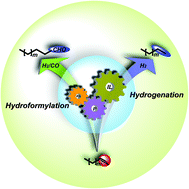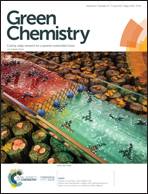Integration of phosphine ligands and ionic liquids both in structure and properties – a new strategy for separation, recovery, and recycling of homogeneous catalyst†
Abstract
The major limitation of classic biphasic ionic liquid (IL) catalysis is the heavy use of solvent ILs, which not only violates green chemistry principles but also even worsens catalytic efficiency. So it has always been a challenge finding ways to use ILs more efficiently, economically, and greenly to construct highly effective and long term stable IL catalytic systems. In this work, we synthesized a class of room temperature phosphine-functionalized polyether guanidinium ionic liquids (RTP-PolyGILs) by a convenient ion exchange reaction of polyether guanidinium ionic liquids (PolyGILs) with phosphine-sulfonate ligands based on the concept of the integration of both the phosphine ligand and IL. The resulting RTP-PolyGILs existed as liquids at room temperature and possessed dual functions of both the phosphine ligand and solvent IL; therefore they could both form catalysts by complexing with transition metals and act as catalyst carriers, thus achieving the integration of phosphine ligands with ILs both in structure and properties. Based on the unique properties of these multi-functional integrated RTP-PolyGILs, we constructed a highly effective homogeneous catalysis-biphasic separation (HCBS) system for Rh-catalyzed hydroformylation of higher olefins using only a catalytic amount of RTP-PolyGILs (equivalent to 0.025–0.4 mol% of 1-alkenes). Our HCBS system could be flexibly regulated with regard to catalytic performance (activity and linear selectivity) by changing the structure or type of the sulfonated ligand anion on RTP-PolyGILs. Specifically, it presented a TOF value of 3000–26 000 h−1 and a linear selectivity of 68%–98% (corresponding to the l/b ratio of 2.2–37.5) with a total turnover number (TTON) of 11 000–45 000 and an extremely low Rh leaching of only 0.02–0.4 ppm. Therefore, the HCBS system can effectively combine the advantages of both homogeneous (high activity and good selectivity) and biphasic catalysis (easy catalyst separation). We additionally extended the application of the HCBS system to the hydrogenation of olefins to demonstrate the universality of the RTP-PolyGILs in catalytic reactions.



 Please wait while we load your content...
Please wait while we load your content...